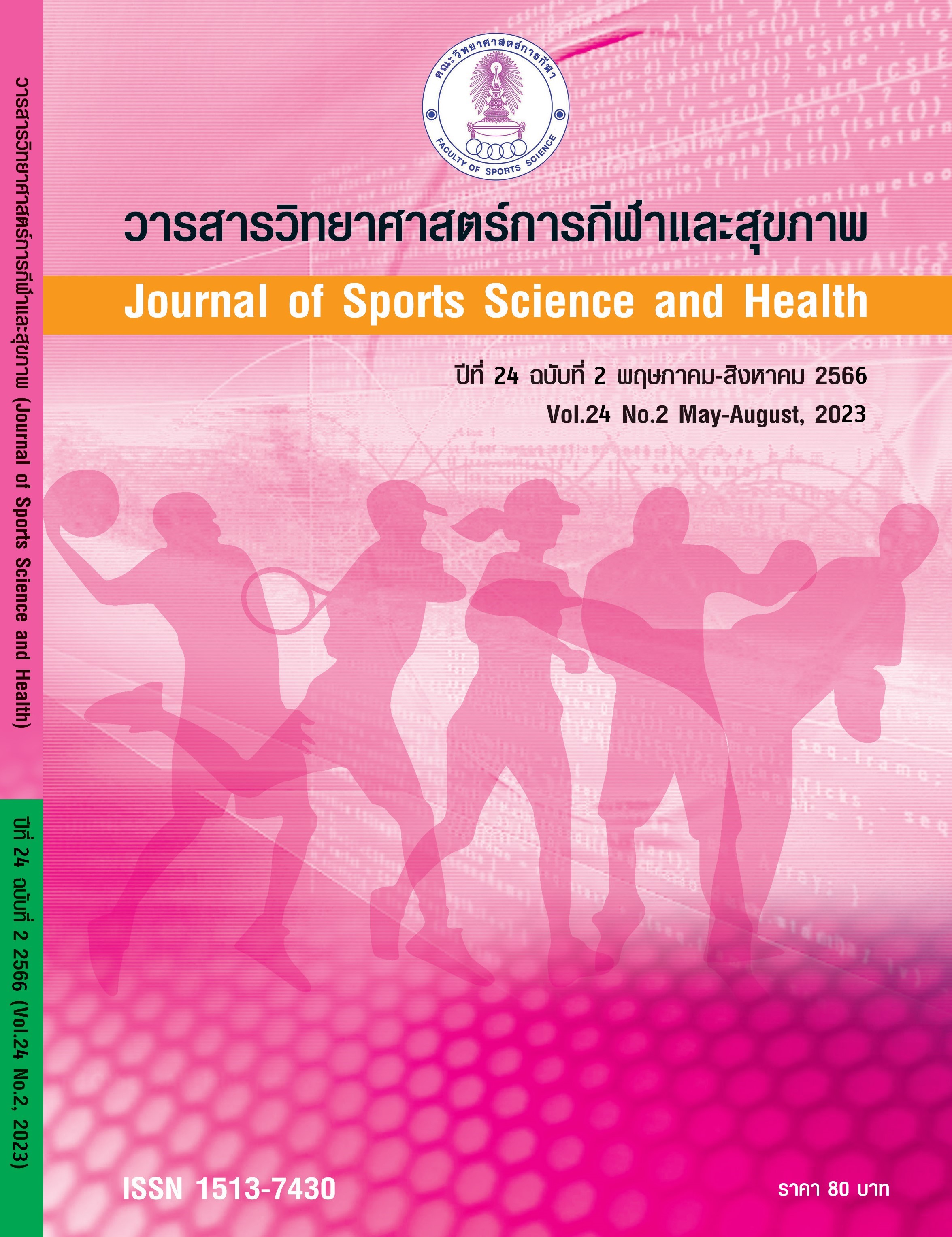EFFECTS OF CHAIR AEROBIC WITH STICK EXERCISE TRAINING ON BLOOD PRESSURE AND CARDIOVASCULAR FUNCTION IN HYPERTENSIVE ELDERLY
Main Article Content
Abstract
Purpose: This study aimed to determine the effects of Chair Aerobic with Plong Exercise training on blood pressure and cardiovascular function, health-related physical fitness and body composition in hypertensive elderly.
Methods: Thirty Four stage-I hypertensive elderly aged 60–75 years were randomized into 2 groups: control group (CON; n=17, Male=5: Female=12) and Chair Aerobic with Plong training group (CSG; n=17, Male=2, Female=15). Participants in CON group had normal daily living activities and did not receive any exercises or treatments. Those in CSG group received chair aerobic with plong training three times a week for 12 weeks. Parameters for blood pressure, cardiovascular functions, health-related physical fitness and body composition were collected at baseline and at the end of 12 weeks. Then, all variables were analyzed with independent t-test and paired t-test with a significant level at p less than 0.05.
Results: The results indicated that after 12 weeks, CSG group had significantly decreased in blood pressures, improved cardiovascular function, higher health-related physical fitness and improved body compositions when compared to CON group (p<.05).
Conclusion: In conclusion, the present findings from our study demonstrated that 12 weeks of Chair Aerobic with Plong training Group improved blood pressure, cardiovascular functions, health-related physical fitness, body composition in hypertensive elderly.
Article Details

This work is licensed under a Creative Commons Attribution-NonCommercial-NoDerivatives 4.0 International License.
References
Brukner, P., & Khan, K. (2007). Sports injuries. Clinical Sports Medicine. 3rd ed. Sydney: Mc Graw Hill.
Glazer. (2008). VCD-Chair aerobics for everyone. The United States of America.
Gupta, V., & Lipsitz, L. A. (2007). Orthostatic hypotension in the elderly: diagnosis and treatment. The American journal of medicine, 120(10), 841-847.
Nursalam, Irwindi, Y. A., Ni'mah, L., & Efendi, F. (2020). The effect of range of motion exercise on blood pressure, pulse and sleep quality among hypertensive patients. International Journal of Innovation, Creativity and Change, 13(6), 220-234.
Kaminsky, L. (2006). ACSM's resource manual for guidelines for exercise testing and prescription. CQUniversity.
Kotani, K., Adachi, S., Tsuzaki, K., Sakane, N., & Gugliucci, A. (2010). The association between resistin, high-density lipoprotein cholesterol and carotid atherosclerosis in elderly women with hypertension. International journal of cardiology, 141(2), 193–194.
Muris, D. M., Houben, A. J., Kroon, A. A., Henry, R. M., van der Kallen, C. J., Sep, S. J., Koster, A., Dagnelie, P. C., Schram, M. T., & Stehouwer, C. D. (2014). Age, waist circumference, and blood pressure are associated with skin microvascular flow motion: the Maastricht Study. Journal of hypertension, 32(12), 2439-2449.
Orem, D. E., & Taylor, S. G. (2011). Reflections on nursing practice science: the nature, the structure, and the foundation of nursing sciences. Nursing science quarterly, 24(1), 35-41.
Pedrinelli, R., Ballo, P., Fiorentini, C., Denti, S., Galderisi, M., Ganau, A., Germanò, G., Innelli, P., Paini, A., & Perlini, S. (2012). Hypertension and acute myocardial infarction: an overview. Journal of cardiovascular medicine, 13(3), 194-202.
Program, N. H. B. P. E. (2004). The seventh report of the joint national committee on prevention, detection, evaluation, and treatment of high blood pressure.
Rubio-Guerra, A. F., Rodriguez-Lopez, L., Vargas-Ayala, G., Huerta-Ramirez, S., Serna, D. C., & Lozano-Nuevo, J. J. (2013). Depression increases the risk for uncontrolled hypertension. Experimental and clinical cardiology, 18(1), 10–12.
Swank, A. M., Funk, D. C., D URHAM, M. P., & Roberts, S. (2003). Adding weights to stretching exercise increases passive range of motion for healthy elderly. The Journal of Strength & Conditioning Research, 17(2), 374-378.
Tanaka, H. (2015). Effects of regular exercise on arterial stiffness. Effects of Exercise on Hypertension: From Cells to Physiological Systems, 185-201.
Thapa, S., & Pattanshetty, R. B. (2016). Effect of Chair aerobics as low intensity exercise training on heart rate, blood pressure and six minute walk distance in post coronary artery bypass graft surgery patients through phase I cardiac rehabilitation. Nepalese heart journal, 13(1), 19-23.
Virani, S. S., Alonso, A., Benjamin, E. J., Bittencourt, M. S., Callaway, C. W., Carson, A. P., Chamberlain, A. M., Chang, A. R., Cheng, S., Delling, F. N., Djousse, L., Elkind, M. S. V., Ferguson, J. F., Fornage, M., Khan, S. S., Kissela, B. M., Knutson, K. L., Kwan, T. W., Lackland, D. T., Lewis, T. T., … American Heart Association Council on Epidemiology and Prevention Statistics Committee and Stroke Statistics Subcommittee (2020). Heart Disease and Stroke Statistics-2020 Update: A Report from the American Heart Association. Circulation, 141(9), e139–e596.
White, D. W., & Fernhall, B. (2015). Effects of exercise on blood pressure and autonomic function and other hemodynamic regulatory factors. Effects of Exercise on Hypertension: From Cells to Physiological Systems, 203-225.
White, D. W., & Raven, P. B. (2014). Autonomic neural control of heart rate during dynamic exercise: revisited. The Journal of physiology, 592(12), 2491-2500.
Wong, T. Y., & Mitchell, P. (2004). Hypertensive retinopathy. New England Journal of Medicine, 351(22), 2310-2317.


